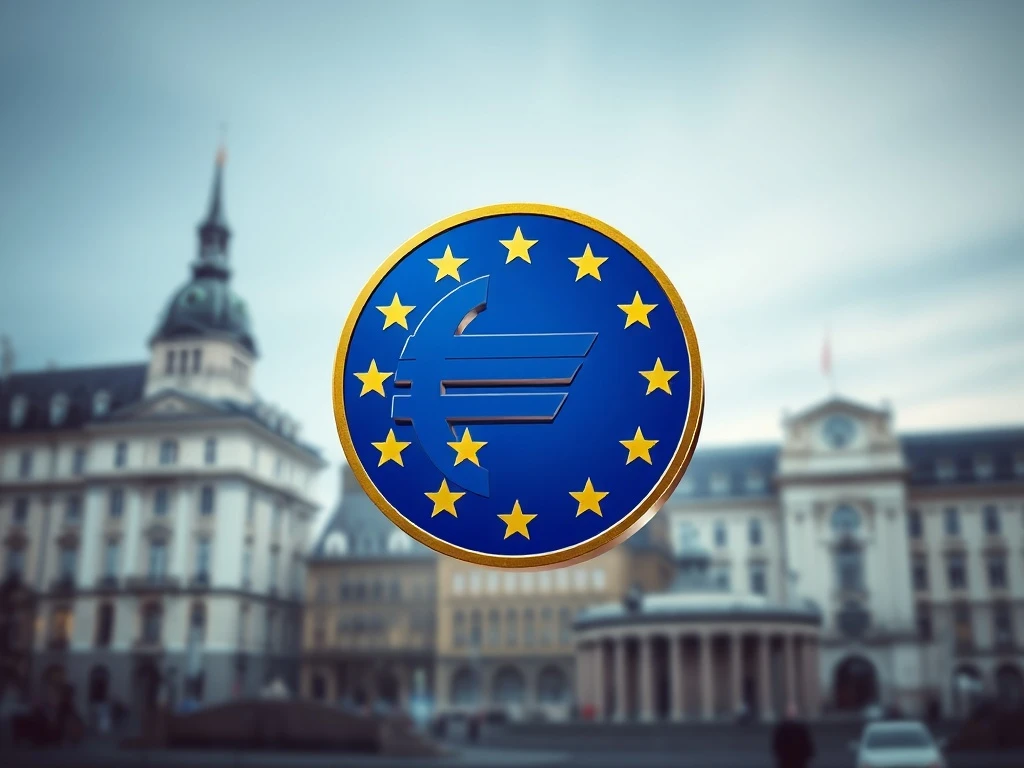Digital Euro: Crucial Launch Delayed Until 2029, ECB Board Member Confirms

The prospect of a **Digital Euro** has long captivated financial markets and policymakers. However, recent announcements suggest a significant shift in its anticipated timeline. Cryptocurrency enthusiasts and global finance watchers alike are closely monitoring the progress of Europe’s central bank digital currency (CBDC). This project aims to reshape digital payments across the continent. Yet, new information indicates that this ambitious initiative will not materialize as quickly as many hoped. The European Central Bank (ECB) has provided a clearer, albeit delayed, outlook.
The Digital Euro: A New Timeline to 2029
Europe’s ambitious **Digital Euro** project faces unexpected delays. Piero Cipollone, an Executive Board member of the European Central Bank (ECB), recently shared a revised timeline. He spoke at a Bloomberg Future of Finance event in Frankfurt. Cipollone stated that the digital currency is unlikely to launch before mid-2029. This assessment pushes the timeline back further than many initially expected. The project, first introduced in October 2020, represents a crucial step for the European Union’s financial future. However, legislative complexities are proving substantial hurdles.
Furthermore, Cipollone’s comments signal a prolonged wait for this pivotal financial innovation. The ECB has been actively discussing the project with EU member states. These discussions aim to ensure broad consensus and address various concerns. Consequently, the mid-2029 projection provides a more realistic, albeit extended, timeframe. This delay occurs despite widespread calls for a prompt launch. Many argue a CBDC is essential to protect Europe’s financial sovereignty. This need is particularly acute amid the growing influence of US stablecoins.
European Parliament: The Key Obstacle for the Digital Euro
The **European Parliament** stands as the primary obstacle to the **Digital Euro**’s swift progression. According to Cipollone, legislative approval from the Parliament is indispensable. Without it, the project cannot advance. The process involves securing a ‘general approach,’ which is an agreement among member states. This agreement is anticipated by the end of the current year. However, the Parliament’s official position on the digital euro is not expected until May 2026. This legislative timeline significantly impacts the overall launch schedule.
Therefore, the parliamentary process introduces a multi-year delay. This delay is critical for such a transformative project. The European Parliament plays a vital role in shaping EU legislation. Its deliberations ensure democratic oversight and thorough review. This careful approach, while necessary, extends the development phase. Recently, EU ministers reached a ‘compromise’ on the digital euro roadmap. This agreement imposes holding limits on the potential digital currency. Irish Finance Minister and Eurogroup President Paschal Donohoe confirmed this development. He stated that the Council of Ministers would have an opportunity for discussion before the ECB makes a final issuance decision.
Understanding the ECB’s Drive for a European CBDC
The **ECB** remains committed to developing a **CBDC** for the Eurozone. Its motivation stems from several strategic objectives. Firstly, a digital euro aims to provide a secure and efficient digital payment option for citizens and businesses. Secondly, it seeks to enhance Europe’s monetary sovereignty. This is particularly relevant in a rapidly evolving global digital finance landscape. The rise of private stablecoins and other digital assets highlights this need. Consequently, the ECB views a CBDC as a necessary evolution of central bank money.
Moreover, the ECB emphasizes the importance of financial stability. A publicly backed digital currency could offer a stable alternative to private digital monies. It could also support innovation in the payments sector. The central bank has been exploring various design options. These include features like offline payments and privacy considerations. Ultimately, the goal is to create a digital euro that is accessible, resilient, and fosters trust. Despite the delays, the strategic rationale for the project remains strong. The ECB believes a digital euro will complement cash, not replace it.
The Road Ahead: Milestones Before 2029
Despite the projected launch in **2029**, European authorities are actively pressing forward with CBDC preparations. The ECB has targeted October for a crucial decision. This decision will determine whether the project moves into its next phase. A spokesperson for the ECB provided further details to Crypto News Insights. An important progress report on the **Digital Euro** is expected from a Member of the European Parliament (MEP) on October 24. This report will be a significant milestone.
Following this report, lawmakers will have six weeks to propose amendments. Subsequently, five additional months are allocated for discussions. These parliamentary procedures are complex and time-consuming. They ensure all stakeholders’ concerns are addressed. The meticulous legislative process aims for a robust and widely accepted digital currency. While the mid-2029 timeline may seem distant, these ongoing steps are vital. They lay the groundwork for a successful and compliant launch. The journey towards a fully operational digital euro is indeed a marathon, not a sprint.
Implications and Future of Europe’s CBDC
The delay in the **Digital Euro** launch until **2029** carries several implications. For consumers, it means a longer wait for a new form of central bank money. For businesses, it extends the period of uncertainty regarding future payment infrastructures. Moreover, the delay might impact Europe’s competitive standing in the global digital currency race. Other nations are also advancing their CBDC projects. However, a cautious approach allows for thorough testing and refinement. This could lead to a more secure and user-friendly digital currency in the long run.
Ultimately, the European Union’s commitment to the digital euro remains firm. The ongoing discussions and legislative steps underscore this dedication. The project aims to provide a public digital payment solution. It will safeguard financial sovereignty and promote innovation. As the European Parliament continues its deliberations, the world watches closely. The eventual launch of the digital euro will undoubtedly mark a transformative moment for Europe’s financial landscape. It promises to redefine how citizens interact with money in the digital age.







